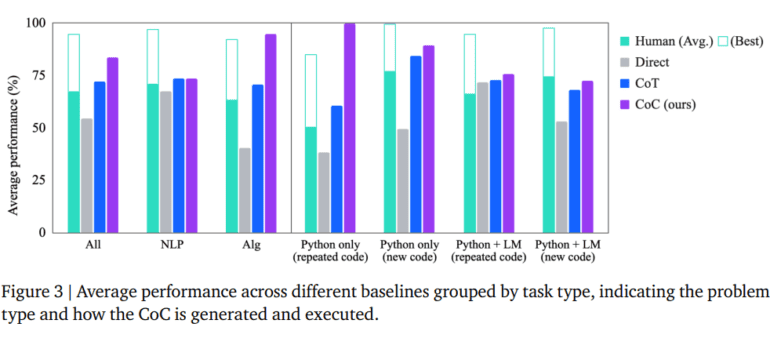TL;DR:
- CoC (Chain of Code) improves code-driven reasoning in language models.
- It encourages semantic sub-tasks in flexible pseudocode.
- LMs can execute code, enhancing numeric and symbolic reasoning.
- CoC excels by executing and simulating code, outperforming rivals.
- It achieves state-of-the-art results, even at larger model sizes.
- Cross-task prompting poses minimal challenges to CoC.
- CoC extends to non-executable code, benefiting semantic reasoning.
Main AI News:
In a groundbreaking collaboration, leading researchers from Google DeepMind, Stanford University, and the University of California, Berkeley, have introduced a transformative approach that promises to revolutionize code-driven reasoning in language models. Known as the Chain of Code (CoC), this innovation empowers language models to navigate semantic sub-tasks within a program using flexible pseudocode. CoC not only captures undefined behaviors but also facilitates their simulation through an “LMulator,” unlocking a new era of problem-solving capabilities for language models.
Much like its predecessors, such as Chain of Thought, least-to-most, and ScratchPad, CoC relies on strategic prompting to enhance reasoning. It dissects complex tasks into manageable intermediate steps and maintains a trace of intermediate results. LMs, trained on vast repositories like GitHub, are encouraged to both generate and execute code, effectively addressing intricate questions involving numeric or symbolic reasoning.
CoC’s methodology involves generating reasoning substeps within a structured code framework. This code can take various forms, including explicit code, pseudocode, or natural language. The true innovation lies in CoC’s ability to harness the power of code alongside the semantic and commonsense knowledge of language models. It enables the seamless expression of rules that would otherwise be challenging to articulate in code, such as determining which items qualify as fruits.
However, the core contribution of CoC extends beyond code generation; it revolutionizes code execution. Once the code is written, it undergoes execution, typically by a code interpreter, with Python being a notable example. If the code executes successfully, it updates the program state, and the process continues. In cases where the code isn’t executable or raises exceptions, the language model steps in to simulate the execution. The language model’s outputs then guide the program state, ensuring the continuity of the process.
Remarkably, CoC’s overall performance surpasses other existing methods, consistently exceeding human baseline performance across a broad spectrum of tasks. Notably, it achieves state-of-the-art results in various studies, showcasing improved performance as model size scales up. Despite the challenges posed by cross-task prompting, CoC maintains its competitive edge, outperforming the Chain of Thought and direct prompting at scale and approaching human-level performance.
Chain of Code (CoC) is a pioneering approach to harnessing the power of language models for reasoning through code. It seamlessly combines the expressive nature of code with the formidable tools at the disposal of language models. Moreover, by simulating the execution of non-executable code, CoC expands its applicability to problems that traditionally lie outside the realm of coding, making it a versatile and indispensable tool for semantic reasoning challenges and beyond.
Conclusion:
The introduction of CoC marks a significant advancement in language model code-driven reasoning. This innovative approach empowers language models to tackle complex tasks with exceptional success, achieving state-of-the-art performance and demonstrating resilience even in the face of cross-task challenges. CoC’s ability to simulate non-executable code broadens its applications, making it a game-changer in the market for semantic reasoning and beyond. Businesses and industries seeking cutting-edge solutions for code-driven tasks should closely monitor the developments in CoC and consider its integration into their workflows to gain a competitive edge.

